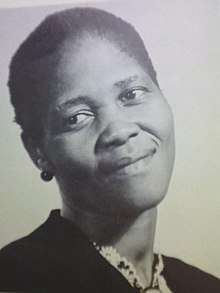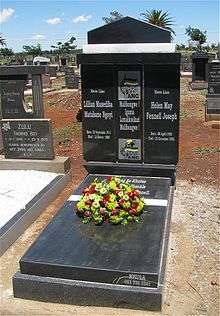Lillian Ngoyi
Lilian Masediba Matabane Ngoyi, "Mma Ngoyi", (25 September 1911 – 13 March 1980), was a South African anti-apartheid activist.[1][2][3][4] She was the first woman elected to the executive committee of the African National Congress, and helped launch the Federation of South African Women.
Lilian Masediba Ngoyi | |
|---|---|
 | |
| Born | Lilian Masediba Matabane 25 September 1911 |
| Died | 13 March 1980 (aged 68) |
| Nationality | South African |
| Other names | Ma Ngoyi |
| Occupation | Politician |
| Known for | Internal resistance to apartheid |

Prior to becoming a machinist at a textile mill, where she was employed from 1945 to 1956, Ngoyi enrolled to become a nurse.[5]
Political activism
She joined the ANC Women's League in 1952; she was at that stage a widow with two children and an elderly mother to support, and worked as a seamstress. A year later she was elected as President of the Women's League. On 9 August 1956, Ngoyi led a women's march along with Helen Joseph, Rahima Moosa, Sophia De Bruyn, Motlalepula Chabaku, Bertha Gxowa and Albertina Sisulu of 20,000 women to the Union Buildings of Pretoria in protest against the apartheid government requiring women to carry passbooks as part of the pass laws.
Lilian Ngoyi was also a transnational figure who recognised the potential influence that international support could have on the struggle against apartheid and the emancipation of black women. With this in mind she embarked on an audacious (and highly illegal) journey to Lausanne, Switzerland, in 1955 to participate in the World Congress of Mothers held by the Women's International Democratic Federation (WIDF). Accompanied by her fellow activist Dora Tamana, and as an official delegate of FEDSAW, she embarked on a journey that would see an attempt to stow away on a boat leaving Cape Town under "white names", defy (with the help of a sympathetic pilot) segregated seating on a plane bound for London and gain entry to Britain under the pretext of completing her course in Bible studies. She would visit England, Germany, Switzerland, Romania, China and Russia, meeting women leaders often engaged in left-wing politics, before arriving back in South Africa a wanted woman.[6]
Ngoyi was known as a strong orator and a fiery inspiration to many of her colleagues in the ANC. She was arrested in 1956, spent 71 days in solitary confinement, and was for a period of 15 years placed under severe bans and restrictions that confined her to her home in Orlando, Soweto.
Memorials and honours
The Koos Beukes Clinic at the Chris Hani Baragwanath Hospital in Soweto has been renamed Lilian Ngoyi Community Clinic in her honour.
On 16 November 2004, the South African Ministry of the Environment launched the lead ship in a class of environmental patrol vessels named Lillian Ngoyi in her honour.[2][3]
On 9 August 2006, the 50th anniversary of the march on Pretoria, Strijdom Square from which the women marched was renamed Lilian Ngoyi Square.[7] 9 August is commemorated in South Africa as Women's Day.
In 2009, a residence hall at Rhodes University was renamed in her honour.[8]
In 2012, Van der Walt Street in Pretoria was renamed Lilian Ngoyi Street. Other roads in Cape Town, Thembisa, Berea, Durban, and Hartbeesfontein have been named in her honour.
The City of Johannesburg decided to honor Mme Lilian Masediba Ngoyi by renaming the Bree Street in Johannesburg after her in 2014 – the street named Lilian Ngoyi Street.
References
- Chris Van Wyk (2006). Lilian Ngoyi. Awareness Publishing. p. 7. ISBN 978-1-77008-160-4. Retrieved 4 December 2011.
-
Richard Davies (16 November 2004). "SA christens first new environmental vessel". Independent Online. Archived from the original on 4 December 2011. Retrieved 4 December 2011.
A sprinkling of holy water and a spray of champagne marked the naming of the first of South Africa's four new environmental protection vessels, the Lilian Ngoyi, in Cape Town harbour on Tuesday.
CS1 maint: BOT: original-url status unknown (link) -
"SA's marine protection vessels". SAinfo. 20 May 2005. Archived from the original on 4 December 2011. Retrieved 4 December 2011.
Lilian Ngoyi rose to prominence during the defiance campaigns of the 1950s and 1960s. She was one of the leaders of the 20 0000-women march to the Union Buildings in 1956 in protest against the pass laws.
CS1 maint: BOT: original-url status unknown (link) - Cathy LaVerne Freeman (10 August 2009). "Relays in Rebellion: The Power in Lilian Ngoyi and Fannie Lou Hame". Georgia State University. Retrieved 4 December 2011.
- "Lilian Masediba Ngoyi". South African History Online. South African History Online. 1 August 2013. Retrieved 19 February 2016.
- "Black History Month: Lilian Masediba Ngoyi (1911–1980)". Women's History Network. 17 October 2010. Archived from the original on 5 December 2011. Retrieved 5 December 2011.CS1 maint: BOT: original-url status unknown (link)
- Kyle G. Brown (28 May 2010). "South Africa's street signs, place names lead to more struggle". Toronto Star. Archived from the original on 5 December 2011. Retrieved 5 December 2011.
The square now bears the name of Lilian Ngoyi, the anti-apartheid activist who, in the 1950s, led marches against laws requiring blacks to carry identification, particularly to enter white areas.
CS1 maint: BOT: original-url status unknown (link) - "Lilian Ngoyi Hall, End of Year Report 2015" (PDF). Rhodes University. Archived from the original on 18 August 2016. Retrieved 17 August 2016.CS1 maint: BOT: original-url status unknown (link)
External links
- ANC historical documents
- Bernstein, Hilda, 1975. For Their Triumphs and for Their Tears – Women in Apartheid South Africa, International Defence & Aid Fund, London, United Kingdom.
- "Women's Anti-Pass Law Campaigns in South Africa", About.com
- Women's Day March – 9 August 1956